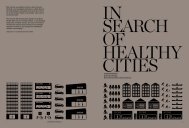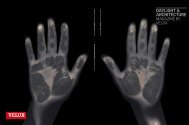Download as PDF - Daylight & Architecture - Magazine by | VELUX
Download as PDF - Daylight & Architecture - Magazine by | VELUX
Download as PDF - Daylight & Architecture - Magazine by | VELUX
You also want an ePaper? Increase the reach of your titles
YUMPU automatically turns print PDFs into web optimized ePapers that Google loves.
Views towards the outside areamong the most important criteriafor the acceptance of buildings.While providing varietywithin the everyday routine oflife, they also help to preventfeelings of claustrophobia.that occupants also supplement daylightwith t<strong>as</strong>k lamps. It is possible that electriclight, whether ceiling or t<strong>as</strong>k, reduceslighting contr<strong>as</strong>ts on work surfaces thatmake some visual work difficult.A post-occupancy evaluation of thefirst LEED Platinum building in the US,the Philip Merrill Environmental Center,shows very high satisfaction with daylight,despite concerns with visual discomfort(Heerwagen and Zagreus, 2005). Thissuggests that people may value the psychologicalbenefits of daylight even whendaylight creates difficulties for work dueto glare and uneven light distribution.Certainly, the kinds of visual t<strong>as</strong>ks weperform in today’s work environmentsare very different from our ancestors’daily t<strong>as</strong>ks. Cooking, tool making, conversing,foraging, and hunting could beeffectively carried out over a wide rangeof luminous conditions. In contr<strong>as</strong>t, readingand computer work require a muchgreater degree of visual acuity that maybe more difficult in some daylit environments.Yet a uniformly lit environmentthat may be appropriate for office worklacks the psychological, and perhaps biological,value of daylight.Attitudes toward <strong>Daylight</strong> andElectric LightA study of office workers in a Seattlehigh-rise building <strong>as</strong>ked respondents tocompare the relative merits of daylightand electric light for psychological comfort,general health, visual health, workperformance, jobs requiring fine observation,and office aesthetics (Heerwagenand Heerwagen, 1986).The results show that the respondentsrated daylight <strong>as</strong> better than electric lightfor all variables, especially for psychologicalcomfort, health and aesthetics. Theyrated daylight and electric light <strong>as</strong> equallygood for visual t<strong>as</strong>ks.At the time of this study in 1986, therew<strong>as</strong> little evidence connecting daylight tohealth. Since that time, however, thereh<strong>as</strong> been a surge of research on the link betweenlight and health, much of it focusingon the circadian system and se<strong>as</strong>onalaffective disorder. Much of this work h<strong>as</strong>been conducted in clinical settings withphototherapy. Since a review of this topicis provided elsewhere in this issue, it willnot be addressed here.However, it is worth noting a laboratorystudy that investigated lighting preferencesof subjects with Se<strong>as</strong>onal AffectiveDisorder (SAD) compared to subjects thatdid not experience se<strong>as</strong>onal changes inmood or other behaviours (Heerwagen,1990). Those who experienced se<strong>as</strong>onalchanges chose significantly higher levelsof brightness for all lighting sources comparedto those who did not. This suggeststhat people experiencing SAD may indeedbe ‘light hungry’ and could benefit fromindoor environments with high daylightlevels, such <strong>as</strong> atria, sunrooms and locationsadjacent to windows.But what do we know about otherhealth impacts of daylight in the builtupenvironment? Research in hospitalsettings, looking at the relationship betweenroom daylight levels and patientoutcomes, found that bi-polar patientsin bright, e<strong>as</strong>t-facing rooms stayed in thehospital 3.7 fewer days on average thanthose in west-facing rooms (Benedettiand others, 2001). Similar results werefound <strong>by</strong> Beauchamin and Hays (1996)for psychiatric in-patients; those in thebrightest rooms stayed in the hospital 2.6fewer days on average. However, neitherof these studies provides data on the actuallight levels in the patient rooms or lightentering the retina, so it is difficult to drawconclusions about exposure levels.More recent research in a Pittsburghhospital actually me<strong>as</strong>ured room brightnesslevels. Walch and others (2005) studied89 patients who had elective cervicaland spinal surgery. Half the patientswere located on the bright side of thehospital, while the other half were in ahospital wing with an adjacent buildingthat blocked sun entering the rooms. Thestudy team me<strong>as</strong>ured medication typesand cost <strong>as</strong> well <strong>as</strong> psychological functioningthe day after surgery and at discharge.The researchers also conducted extensivephotometric me<strong>as</strong>urements of light ineach room, including light levels at thewindow, on the wall opposite the patient’sbed, and at the head of the bed (which presumablywould have been at or near the20 D&A SPRING 2011 Issue 15










